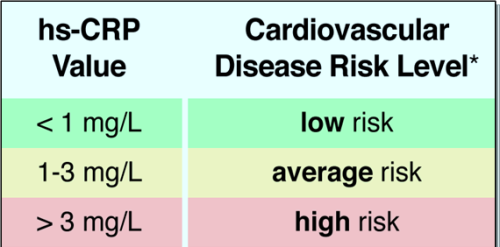While a staggering 50% of h eart attacks occur in people with normal cholesterol, myself and other researchers now recognize that nearly all cases of chronic disease, cancer and heart attacks are consistently accompanied by preexisting elevated sub-clinical inflammation. Elevated low grade inflammation promotes everything from Multiple Sclerosis, heart disease, cancer, diabetes, chronic pain, arthritis, constipation/diarrhea and low energy.
eart attacks occur in people with normal cholesterol, myself and other researchers now recognize that nearly all cases of chronic disease, cancer and heart attacks are consistently accompanied by preexisting elevated sub-clinical inflammation. Elevated low grade inflammation promotes everything from Multiple Sclerosis, heart disease, cancer, diabetes, chronic pain, arthritis, constipation/diarrhea and low energy.
How do you test for inflammation?
hs-CRP
How does it work?
The test detects low concentrations of C-reactive protein to help predict a person’s risk of heart disease.
What does it mean?
Many researchers are now finding a healthy hs-CRP is below 0.5 and even below 0.1 as being ideal. For years, my hs-CRP has been consistently under 0.1 once I understood the inflammatory concept and began self testing while concurrently integrating anti-inflammatory habits.
hs-CRP Blood Test Risk Ranges:
Low risk: less than 1.0mg/L
Medium risk: 1-3.0mg/L
High risk: above 3.0-10mg/LWhile
Extreme or Acute risk: over 10mg/L
Note:
Do not let all your decisions rest on hs-CRP. While a positive test is the best for measuring subclinical inflammation, a low or negative test does not guarantee low inflammation. It can only confirm high inflammation and lend guidance in understanding how your lifestyle decisions are impacting your body’s chemistry in accelerating or slowing aging and disease manifestation. Other inflammatory tests exist. However, these tests are typically less sensitive in predictive value when compared with hs-CRP.

